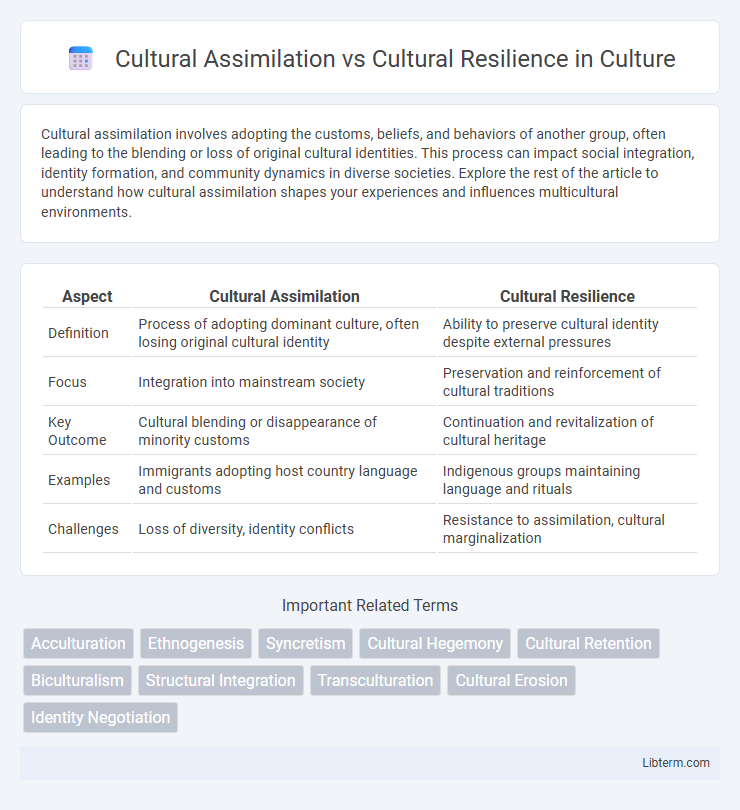Cultural assimilation involves adopting the customs, beliefs, and behaviors of another group, often leading to the blending or loss of original cultural identities. This process can impact social integration, identity formation, and community dynamics in diverse societies. Explore the rest of the article to understand how cultural assimilation shapes your experiences and influences multicultural environments.
Table of Comparison
| Aspect | Cultural Assimilation | Cultural Resilience |
|---|---|---|
| Definition | Process of adopting dominant culture, often losing original cultural identity | Ability to preserve cultural identity despite external pressures |
| Focus | Integration into mainstream society | Preservation and reinforcement of cultural traditions |
| Key Outcome | Cultural blending or disappearance of minority customs | Continuation and revitalization of cultural heritage |
| Examples | Immigrants adopting host country language and customs | Indigenous groups maintaining language and rituals |
| Challenges | Loss of diversity, identity conflicts | Resistance to assimilation, cultural marginalization |
Understanding Cultural Assimilation
Cultural assimilation involves the process by which individuals or groups adopt the language, customs, values, and behaviors of another culture, often leading to the reduction of their original cultural identity. This phenomenon is frequently observed in immigrant populations where societal pressures and policies encourage conformity to the dominant culture. Understanding cultural assimilation requires analyzing factors such as social integration, acculturation strategies, and the impact on ethnic identity maintenance.
Defining Cultural Resilience
Cultural resilience refers to the ability of a community or group to preserve and strengthen its cultural identity, values, traditions, and practices despite external pressures, such as globalization, colonization, or migration. It emphasizes adaptive strategies that allow cultural continuity while integrating beneficial changes, ensuring the survival of unique heritage and social norms. This concept contrasts with cultural assimilation, where minority groups gradually adopt dominant cultural traits, often losing distinct cultural elements in the process.
Historical Perspectives on Cultural Change
Historical perspectives on cultural change reveal that cultural assimilation often occurred through colonization, where dominant powers imposed their values and practices on indigenous populations. In contrast, cultural resilience showcases the ability of marginalized communities to preserve and adapt their traditions despite external pressures and assimilation efforts. Key examples include Native American resistance to European colonization and the preservation of African cultural practices throughout the transatlantic slave trade.
Key Drivers of Assimilation
Key drivers of cultural assimilation include socioeconomic pressures, education systems, and media influence, which encourage individuals to adopt dominant cultural norms and values. Immigration policies and urbanization also play significant roles by fostering environments where minority groups interact frequently with majority populations, accelerating assimilation. Language acquisition and intermarriage further facilitate the blending of cultures, often at the expense of preserving original cultural identities.
Factors Fostering Cultural Resilience
Factors fostering cultural resilience include strong community bonds, preservation of traditional languages, and intergenerational transmission of customs and knowledge. Access to education that respects and incorporates indigenous perspectives reinforces cultural identity and empowerment. Supportive policies and initiatives promoting cultural expression and participation help communities maintain their unique heritage amidst external pressures.
The Role of Identity in Cultural Dynamics
Identity serves as the core determinant in cultural dynamics, influencing whether individuals gravitate toward cultural assimilation or cultural resilience. When personal and group identities align closely with mainstream cultural norms, assimilation tends to occur, fostering integration into dominant societies. Conversely, strong attachment to heritage identity promotes cultural resilience, enabling communities to preserve distinct traditions and resist homogenizing pressures.
Impacts on Minority and Indigenous Communities
Cultural assimilation often leads to the erosion of minority and Indigenous identities, diminishing languages, traditions, and social structures essential to community cohesion. Cultural resilience empowers these communities to preserve and revitalize their heritage, supporting mental health and socio-economic stability. Studies show that strong cultural resilience correlates with improved educational outcomes and reduced rates of substance abuse in Indigenous populations.
Case Studies: Assimilation vs Resilience
Case studies of cultural assimilation versus cultural resilience reveal distinct outcomes in community identity preservation. The Navajo Nation's efforts exemplify cultural resilience through language revitalization and traditional practices, resisting external assimilation pressures. In contrast, indigenous groups in Australia experienced significant assimilation impacts, including loss of language and customs, highlighting challenges faced when dominant cultures impose integration policies.
Cultural Assimilation and Globalization
Cultural assimilation involves the process by which individuals or groups adopt the cultural traits of a dominant or host society, often leading to the loss of original cultural identities. Globalization accelerates cultural assimilation by increasing cross-cultural interactions through media, trade, and migration, creating pressures to conform to global norms and practices. This dynamic can diminish cultural diversity as local traditions and languages are overshadowed by dominant global cultures.
Strategies for Promoting Cultural Resilience
Strategies for promoting cultural resilience emphasize community engagement, preservation of language, and education that incorporates indigenous knowledge and traditions. Empowering cultural institutions and supporting intergenerational transmission of customs fortify identity against assimilation pressures. Policies fostering cultural pluralism and inclusive representation in media further strengthen societal appreciation and resilience of diverse cultures.
Cultural Assimilation Infographic

 libterm.com
libterm.com